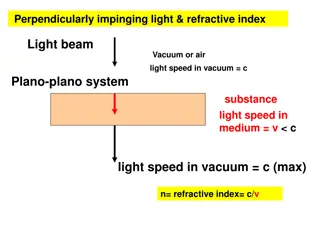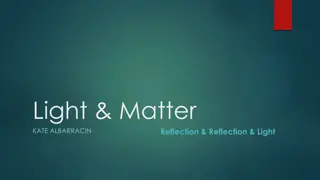Understanding Reflection and Refraction of Light
Explore the fascinating world of reflection and refraction of light, delving into concepts such as the laws of reflection, real vs. virtual images, characteristics of mirror-formed images, and the types of spherical mirrors - concave and convex. Discover how light behaves when it interacts with different surfaces and mirrors, shaping our understanding of optics.
Download Presentation

Please find below an Image/Link to download the presentation.
The content on the website is provided AS IS for your information and personal use only. It may not be sold, licensed, or shared on other websites without obtaining consent from the author. Download presentation by click this link. If you encounter any issues during the download, it is possible that the publisher has removed the file from their server.
E N D
Presentation Transcript
Reflection of Light The process of sending back light rays which falls on the surface of an object is called REFLECTION of light Silver metal is one of the best reflectors of light. Mirrors we use on our dressing tables in our home are plane mirrors. A ray of light is the straight line along which the light traveled and a bundle of light rays is called a beam of light.
Laws of Reflection of light 1. The angle of incidence is equal to the angle of reflection, and 2. The incident ray, the reflected ray and the normal to the mirror at the point of incidence all lie in the same plane. These laws of reflection are applicable to all types of reflecting surfaces including spherical surfaces
Real and Virtual images An image is formed when the light rays coming from an object meet at a point after reflection from a mirror (or refraction from lens). The images are of two types 1. Real Images:- Real images are formed when rays of light that comes from an object (or source) meets at a point after reflection from a mirror (or refraction from a lens). Real images can be formed on a screen and can be seen with the eyes. 2. Virtual images:- Virtual image is an image in which the outgoing rays from an object do not meet at a point. It will appear to meet at a point in or behind the optical device (i.e., a mirror) but they do not actually meet after reflection from a mirror (or refraction from a lens). A plane mirror always forms virtual images.
Characteristics of images formed by mirrors:- (a) Images formed by mirrors are always virtual and erect (b) Size of image is always equal to the size of the object and the image is laterally inverted. (c) The images formed by the plane mirror are as far behind the mirror as the object in front of the mirror. Lateral inversion:- If an object is placed in front of the mirror, then the right side of the object appears to be the left side and left side of the object appears to be the right side of this image. This change of sides of an object and its mirror image is called lateral inversion.
Spherical Mirrors The reflecting surface of a spherical mirror may be curved inwards or outwards. Spherical mirrors are of two types 1. Concave mirror: - In a concave mirror reflection of light takes place at the concave surface or bent-in surface as shown below in the
2. Convex mirror:- In a convex mirror reflection of light takes place at the convex surface or bent out surface as shown below in the figure Commonly used terms about Spherical mirrors :-
Principle focus and focal length of a Spherical Mirrors For understanding about principle focus and focus length of a spherical mirror first consider the figure given below
Image Formation by Spherical mirrors Rules for obtaining images formed by spherical mirrors (1) Rule 1 A ray of light which is parallel to the principle axis of the mirror passes through its focus after reflection from the mirror as shown below in the figure
(2) Rule 2 A ray of light passing through the center of curvature of the curvature of the concave mirror or directed in the direction of the center of curvature of a convex mirror, is reflected back along the same path as shown below in the figure
(3) Rule 3 A ray passing through principle focus of a concave mirror or a ray which is directed towards the principal focus of a convex mirror, becomes parallel to the principle axis after reflection and is shown below in the figure
(4) Rule 4 A ray incident obliquely to the principal axis, towards a point P (pole of the mirror), on the concave mirror or a convex mirror, is reflected obliquely. The incident and reflected rays follow the laws of reflection at the point of incidence (point P), making equal angles with the principal axis and is shown below in the figure
FORMATION OF DIFFERENT TYPES OF IMAGES BY A CONCAVE MIRROR Different types of images can be formed by a concave mirror by changing the position of the object from the concave mirror. Therefore different types of images are formed when the object is placed 1. At the infinity 2. Beyond the centre of curvature 3. At the centre of curvature 4. Between centre of curvature and principal focus 5. At the principal focus 6. Between the principal focus and pole
1. Image formed by a concave mirror when the object is placed at infinity When the object is placed at infinity, the two rays AB and DE running parallel to the principal axis get reflected at point B and E respectively and intersect each other at the principal focus F on the principal axis. Therefore, in this case the image is formed at the principal focus which is highly diminished, real and inverted.
2. When the object is placed beyond the centre of curvature When the object AB is placed beyond the centre of curvature then a ray of light AD which is parallel to the principal axis and another ray AE which pass through the centre of curvature intersect each other after reflection at point A between the focus and centre of curvature. Thus the image formed is between the principal focus F and centre of curvature C, diminished, real and inverted.
3. When the object is placed at the centre of curvature When the object AB is placed at the centre of curvature C, then a ray of light AD which is parallel to the principal axis and another ray AE which pass through the principal focus intersect each other after reflection at point A just below the position of the object. Thus the image formed in this case is at the centre of curvature, of same size as the object, real and inverted
4. When the object is placed between the centre of curvature and principal focus When the object AB is placed between the centre of curvature and principal focus, then the ray AD running parallel to the principal axis and another ray AE passing through the principal focus F intersect each other at point A beyond the centre of curvature. Thus the image formed in this case is beyond C, enlarged, real and inverted.
5. When the object is placed at principal focus When the object AB is placed at the principal focus, then the parallel ray of light AD passes through the principal focus F giving us the reflected ray DX. And the second ray of light AE passing through the centre of curvature C is reflected along the same path forming the reflected ray EY. In this case, both the reflected rays i.e. DX and EY become parallel to each other so these rays cannot intersect each other and the image will be formed at infinity. The image formed in this case will be highly enlarged, real and inverted.
6. When the object is placed between the principal focus and the pole When the object AB is placed between the principal focus and the pole, then the parallel ray of light AD passes through the focus F giving us the reflected ray DX. And the second ray AE passing through the centre of curvature C is reflected along the same path forming the reflected ray EY.
Table: Summary of images formed by a concave mirror S No. Position of Object Position of Image Size of Image Nature of Image 1. At infinity At the focus F Highly diminished Real and inverted Beyond curvature C the centre of 2. Between F and C Diminished Real and inverted 3. At the centre of curvature C At C Same size Real and inverted 4. Between C and F Beyond C Enlarged Real and inverted 5. At focus F At infinity Highly enlarged Real and inverted
Sign convention for reflection by spherical mirrors Reflection of light by spherical mirrors follow a set of sign conventions called the New Cartesian Sign Convention. In this convention, the pole (P) of the mirror is taken as the origin. The principal axis of the mirror is taken as the x-axis (X'X) of the coordinate system. The conventions are as follows - The object is always placed to the left of the mirror. This implies that the light from the object falls on the mirror from the left-hand side. All distances parallel to the principal axis are measured from the pole of the mirror. All the distances measured to the right of the origin (along + x-axis) are taken as positive while those measured to the left of the origin (along - x-axis) are taken as negative. Distances measured perpendicular to and above the principal axis (along + y-axis) are taken as positive. Distances measured perpendicular to and below the principal axis (along -y-axis) are taken as negative.























